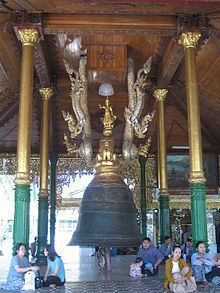Type Temple Bell Height 2.13 m Width 2.01 m | Opening date 17 January 1779 Opened 17 January 1779 Completion date 1779 Beginning date 1776 | |
 | ||
Material bronze23,000-25,000 kg Similar Shwedagon Pagoda, Sule Pagoda, Chaukhtatgyi Buddha Temple, Kandawgyi Lake, Botataung Pagoda | ||
The Singu Min Bell (Burmese: စဉ့်ကူးမင်း ခေါင်းလောင်းတော်), also known as the Maha Gandha Bell, is a large bell located at the Shwedagon Pagoda in Yangon, Myanmar (Burma). It was donated in 1779 by King Singu, the fourth king of Konbaung Dynasty. The official Pali name of the bell is Maha Gandha, which means "Great Sound".
Contents
Description
The bell weighs about 23-25 tons and measures 2.13 metres (7.0 ft) high, 2.01 metres (6.6 ft) wide at the mouth and 0.305 metres (1.00 ft) thick. There are twelve lines of inscription on the bell. The inscriptions describe King Singu, who came to the throne on 9 June 1776, who ruled over the country of 16 provinces, cast and donated the bell to the Shwedagon Pagoda on 17 January 1779.
History
The bell was cast between 1776 and 1779. In 1825, British attempted to take it from the pagoda during first Anglo-Burmese War. However, the ship that carried the bell to Calcutta sank in Yangon River together with the bell. After several unsuccessful attempts to salvage the bell, British finally gave up. Then, a group of Burmese people successfully raised the bell from the riverbed and restored to its original position at the pagoda.
Current status
The bell is housed in a pavilion located on the northwest side of the pagoda's middle terrace.
